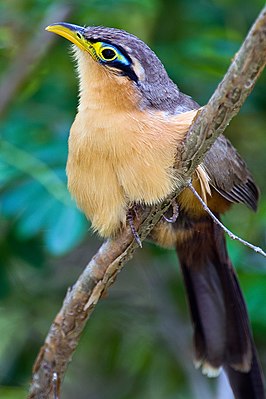Thrush cuckoo
| Thrush cuckoo | ||||||||||||
|---|---|---|---|---|---|---|---|---|---|---|---|---|

Thrush Cuckoo ( Morococcyx erythropygus ) |
||||||||||||
| Systematics | ||||||||||||
|
||||||||||||
| Scientific name of the genus | ||||||||||||
| Morococcyx | ||||||||||||
| PL Sclater , 1862 | ||||||||||||
| Scientific name of the species | ||||||||||||
| Morococcyx erythropygus | ||||||||||||
| ( Lesson , 1842) |
The throttle Cuckoo ( Morococcyx erythropygus ) is a cuckoo in North and Central America and the only member of the genus Morococcyx . The species includes two subspecies : M. e. erythropygus ( Lesson 1842) and M. e. mexicanus ( Ridgway 1915).
features
The thrush cuckoo is about 25–28 cm tall. There is no such thing as gender dimorphism . The chest plumage of the nominate form M. e. erythropygus is reddish to cinnamon in color, the top is glossy gray-brown to olive-brown in color. The yellow-blue, featherless eye ring, which is surrounded by black feathers, is striking. The lower beak is yellow, the back of the beak black. The long tail feathers are brown, the long legs brown to yellow in color. The subspecies M. e. mexicanus is on average larger than the nominate form, and the colors of the plumage appear paler.
The generic name Morococcyx refers to the brightly colored face and is derived from the Greek words “moros” (clown) and “kokkux” (cuckoo).
distribution and habitat
The thrush cuckoo lives in arid and semi-arid open landscapes , forest edges and plantations, e.g. B. Agave plantations . The distribution area of the nominate form of the thrush cuckoo ( M. e. Erythropygus ) stretches from southern Mexico (state of Oaxaca ) to the north-west of Costa Rica . The distribution area of the subspecies M. e. mexicanus joins north along the Pacific Ocean in Mexico to the state of Sinaloa .
The population size is estimated at 50,000 to 499,999 individuals. In addition, the distribution area is large, so that the IUCN regards the thrush cuckoo as not endangered (“least concern”).
Way of life
Thrush cuckoos , like other species of the ground cuckoo family , mostly move on the ground. In contrast to the racing cuckoos, they remain quietly in one place when there is danger . The food, which mainly consists of insects , mostly short-antennae terrors and beetles , is also collected from the ground or in the shrub layer. The nest is built on the ground and the young are raised by both parents. In contrast to other cuckoo birds, the thrush cuckoo is not a breeding parasite .
literature
- Johannes Erritzøe , Clive F. Mann, Frederik Brammer, Richard A. Fuller: Cuckoos of the World (Helm Identification Guides) . Christopher Helm Publishers Ltd, London 2012, ISBN 978-071-366-034-0 .
- Robert B. Payne: The Cuckoos (Bird Families of the World No. 15). Oxford University Press, Oxford 2005, ISBN 0-19-850213-3 .
Individual evidence
- ^ Payne pp. 191-192
- ^ Payne, p. 193
- ↑ Erritzoe et al. P. 124
- ↑ Morococcyx erythropygus in the endangered Red List species the IUCN 2013. Posted by: BirdLife International, 2012. Accessed November 24, 2013.
- ↑ Erritzoe et al. P. 125
Web links
- Morococcyx erythropygus inthe IUCN 2013 Red List of Threatened Species . Listed by: BirdLife International, 2012. Retrieved November 24, 2013.
- BirdLife International: Species Factsheet - Lesser Ground-cuckoo ( Morococcyx erythropygus ) . Retrieved September 26, 2013.
- Videos, photos and sound recordings of Lesser Ground-cuckoo (Morococcyx erythropygus) in the Internet Bird Collection
- Thrush Cuckoo ( Morococcyx erythropygus ) at Avibase; Retrieved September 26, 2013.
- Morococcyx erythropygus in the Integrated Taxonomic Information System (ITIS). Retrieved September 26, 2013.
- xeno-canto: Sound recordings - Lesser Ground-cuckoo ( Morococcyx erythropygus )
